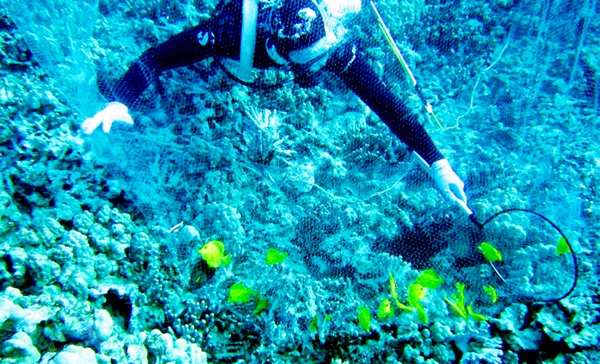HONOLULU — The nonprofit environmental-law organization Earthjustice on Wednesday filed a civil complaint in First Circuit Court in Honolulu against the state of Hawai‘i and the state Department of Land and Natural Resources, seeking to stop all commercial collection of
HONOLULU — The nonprofit environmental-law organization Earthjustice on Wednesday filed a civil complaint in First Circuit Court in Honolulu against the state of Hawai‘i and the state Department of Land and Natural Resources, seeking to stop all commercial collection of aquarium fish until the industry complies with the Hawai‘i Environmental Police Act.
“DLNR owes it to the people of Hawai‘i to take a hard look at the effects of aquarium collection on our coral reefs before it allows these ecologically valuable animals to be shipped to the Mainland for private profit,” Earthjustice attorney Caroline Ishida said in a press release Wednesday.
DLNR Chair William Aila Jr. sent a short statement on the same day, deferring comments.
“The Attorney General’s Office is reviewing the complaint and the department has no further comments until that review is done,” Aila states.
Earthjustice filed the suit on behalf of the Center for Biological Diversity, the Humane Society of the United States, the Conservation Council for Hawai‘i, Rene Umberger, Mike Nakachi, Kaimi Kaupiko and Willie Kaupiko.
“The goal is to have aquarium (fish and invertebrates) collecting stop unless and until a proper Environmental Assessment is conducted,” said Umberger, a Maui resident and the director of the environmental group For the Fishes.
If permits are to be issued, there has to be data on the impacts to ecosystems and fish populations, she said. “They don’t know any of that information; none of it.”
DLNR data shows that about 75 percent of the state’s aquarium fish collection comes from Big Island’s west coast, and 99 percent of invertebrates caught in the state comes from O‘ahu’s nearshore waters, according to the complaint.
Umberger said specially rare fish are now being targeted on Kaua‘i, because they have become extremely rare on other islands due to over-collection.
In 2010, an O‘ahu man died on Kaua‘i two hours after resurfacing from a deep dive. He had been diving for three days in pursuit of the extremely rare and expensive masked angelfish, found at depths of 250 to 300 feet, according to Robert Wintner, executive director of Snorkel Bob Foundation. Wintner said that just prior to the man’s death, a pair of the masked angelfish was sold for $30,000.
An annual report provided by DLNR shows that last year, 36 licensees on Big Island caught 500,123 fish and marine invertebrates, with 481,369 sold for a total of $1.49 million. On O‘ahu, 42 licensees in 2011 caught 221,054 fish and marine invertebrates, with 219,780 sold for a total of $713,668.
Yellow tangs were the fish targeted the most by the trade. On Big Island, there were 284,733 yellow tangs caught, and 283,708 sold. On O‘ahu, there were 19,581 yellow tangs caught, and 19,532 sold. The yellow tang sold for an average of $3.92 per fish.
On Big Island, there were 150,610 red pond shrimps caught, and 133,980 sold, at 37 cents each.
On O‘ahu, there were 83,822 hermit crabs caught, and 83,645 sold, at 13 cents each.
The majority of the fish sold for a few dollars, but some reached more than $100.
Some of the most expensive fish were the Tinker’s butterflyfish, which sold at about $125 each when caught on O‘ahu and $81 each when caught on Big Island; the dragon moray, which sold for about $220 each on O‘ahu, the black banded, bandit angelfish, which sold for about $142 each when caught on O‘ahu and $114 each when caught on Big Island, and the crosshatch humu, which sold for about $81 each on O‘ahu,
On Kaua‘i and Maui, the DLNR data shows “n.a.” (not applicable), and the reason is because when there are less than three collectors on a given island, the DLNR doesn’t provide specific statistics, according to Umberger.
The DLNR wasn’t able to respond by press time what “n.a.” meant in the report.
Complaint
Hawai‘i is the largest exporter of aquarium trade species in the United States, according to the complaint, which alleges that in the 120 days prior to the filling of the complaint, DLNR approved more than 50 collection permits without a required HEPA review.
“DLNR regulates the removal of marine species from state waters for the aquarium trade. The Hawai‘i Division of Aquatic Resources is the division within DLNR responsible for evaluating applications for collection permits. Because collection permits require the use of state lands, which include the state’s waters, approval of collection permits is subject to HEPA, which mandates a specific process whereby DLNR must require a thorough study of the potential impacts of collection permitting, as well as available alternatives and mitigation, before approving or renewing the challenged collection permits,” the complaint states.
However, DLNR has never examined under HEPA the impact of issuing such permits allowing the collection for the aquarium trade on the scale that has been occurring, according to the complaint.
The plaintiffs are seeking that the First Circuit Court issue:
• A declaratory judgment that DLNR is in violation of HEPA for failing to complete the mandated review process prior to approving aquarium collection permits; and a declaratory judgment that DLNR’s issuance and renewal of the permits without HEPA compliance is illegal.
• A prohibitory injunction enjoining collection under the aquarium collection permits until the defendant fully complies with HEPA.
• A prohibitory injunction enjoining DLNR from approving, renewing or issuing any aquarium collection permits prior to completing a HEPA review of issuance of the permits.
The complaint also seeks that the court retain continuing jurisdiction that the defendant complies with the judgment and orders and that the cost of the suit, including legal fees, is reimbursed to the plaintiffs.
• Léo Azambuja, staff writer, can be reached at 245-3681 (ext. 252) or lazambuja@ thegardenisland.com.


